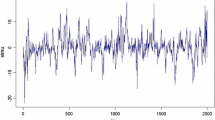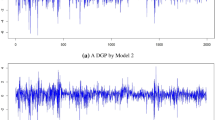Abstract
A Zero-drift GARCH (ZD-GARCH) model is recently proposed to study conditional and unconditional heteroskedasticity together. Despite its attractive statistical properties, our research demonstrates that the stability test based on this model fails when structural changes are present. To overcome this issue, we allow the Markov regime-switching (MRS) feature within the ZD-GARCH framework and propose an MRS-ZD-GARCH model. A revised stability estimator is further derived. The effectiveness of our proposed approach to test the stability with and without structural changes is evidenced via simulation studies. Using the empirical data of the S&P 500, NASDAQ and Apple returns, we show that the new model can also outperform the ZD-GARCH model in practice and provide more informative results. Therefore, the MRS-ZD-GARCH model could be a widely useful tool to study the stability of financial data and help address risk management issues in other contexts.



Similar content being viewed by others
Notes
In this paper, we focus on \(|y_t|^2\), which is the \(r=2\) case described in Li et al. (2018). Other common choices are also tested and lead to robust results, which are available upon request.
Assume that the proportions of low- and high-persistence regimes are both 50%.
We have also considered various settings with more than two groups of distinct state-dependent variables. Results of those additional scenarios are robust and available upon request.
It can be shown that both state-dependent \(\gamma _{0}\) are close to 0. Thus, return sequences is essentially switching between two stable processes.
References
Ang, A., & Timmermann, A. (2011). Regime changes and financial markets. National Bureau of Economic Research: Technical report.
Bali, T. G., & Theodossiou, P. (2007). A conditional-SGT-var approach with alternative Garch models. Annals of Operations Research, 151(1), 241–267.
Bauwens, L., Preminger, A., & Rombouts, J. V. (2010). Theory and inference for a Markov switching Garch model. The Econometrics Journal, 13(2), 218–244.
Bollerslev, T. (1986). Generalized autoregressive conditional heteroskedasticity. Journal of Econometrics, 31(3), 307–327.
Cai, J. (1994). A Markov model of switching-regime arch. Journal of Business & Economic Statistics, 12(3), 309–316.
Cano-Berlanga, S., & Giménez-Gómez, J. M. (2018). On Chinese stock markets: How have they evolved over time? Annals of Operations Research, 266(1–2), 499–510.
Chan, N. H., Deng, S. J., Peng, L., & Xia, Z. (2007). Interval estimation of value-at-risk based on Garch models with heavy-tailed innovations. Journal of Econometrics, 137(2), 556–576.
Dueker, M. J. (1997). Markov switching in GARCH processes and mean-reverting stock-market volatility. Journal of Business & Economic Statistics, 15(1), 26–34.
Engle, R. F. (1982). Autoregressive conditional heteroskedasticity with estimates of variance of united kingdom inflation. Economerica, 50(4), 987–1007.
Feng, L., & Shi, Y. (2017a). Fractionally integrated Garch model with tempered stable distribution: A simulation study. Journal of Applied Statistics, 44(16), 2837–2857.
Feng, L., & Shi, Y. (2017b). A simulation study on the distributions of disturbances in the Garch model. Cogent Economics & Finance, 5(1), 1355503.
Francq, C., Roussignol, M., & Zakoian, J. M. (2001). Conditional heteroskedasticity driven by hidden Markov chains. Journal of Time Series Analysis, 22(2), 197–220.
Francq, C., Zakoı, J. M., et al. (2008). Deriving the autocovariances of powers of Markov-switching Garch models, with applications to statistical inference. Computational Statistics & Data Analysis, 52(6), 3027–3046.
Franses, P., & van Dijk, D. (1996). Forecasting stock volatility using (non-linear) GARCH models. Journal of Forecasting, 15, 229–235.
French, K. R., Schwert, G., & Stambaugh, R. F. (1987). Expected stock returns and volatility. Journal of Financial Economics, 19(1), 3–29.
Garman, M. B., & Klass, M. (1980). On the estimation of security price volatilities from. The Journal of Business, 53(1), 67–78.
Gerencsér, L., & Orlovits, Z. (2012). Real time estimation of stochastic volatility processes. Annals of Operations Research, 200(1), 223–246.
Glosten, L. R., Jagannathan, R., & Runkle, D. E. (1993). On the relation between the expected value and the volatility of the nominal excess return on stocks. The Journal of Finance, 48(5), 1779–1801.
Gray, S. F. (1996). Modeling the conditional distribution of interest rates as a regime-switching process. Journal of Financial Economics, 42(1), 27–62.
Haas, M., & Paolella, M. S. (2012). Mixture and regime-switching GARCH models. In L. Bauwens, C. Hafner, & S. Laurent (Eds.), Handbook of volatility models and their applications (pp. 71–102). London: Wiley.
Haas, M., Mittnik, S., & Paolella, M. S. (2004). A new approach to Markov-switching GARCH models. Journal of Financial Econometrics, 2(4), 493–530.
Hafner, C. M., & Preminger, A. (2015). An ARCH model without intercept. Economic Letters, 129, 13–17.
Hamilton, J. D. (1988). Rational-expectations econometric analysis of changes in regime: An investigation of the term structure of interest rates. Journal of Economic Dynamics and Control, 12(2–3), 385–423.
Hamilton, J. D. (1989). A new approach to the economic analysis of nonstationary time series and the business cycle. Econometrica, 57(2), 357–384.
Hamilton, J. D., & Susmel, R. (1994). Autoregressive conditional heteroskedasticity and changes in regime. Journal of Econometrics, 64(1), 307–333.
Ho, K. Y., Shi, Y., & Zhang, Z. (2013). How does news sentiment impact asset volatility? Evidence from long memory and regime-switching approaches. North American Journal of Economics and Finance, 26, 436–456.
Ho, K. Y., Shi, Y., & Zhang, Z. (2016). It takes two to tango: A regime-switching analysis of the correlation dynamics between the mainland Chinese and Hong kong stock markets. Scottish Journal of Political Economy, 63(1), 41–65.
Ho, K. Y., Shi, Y., & Zhang, Z. (2020). News and return volatility of Chinese bank stocks. International Review of Economics & Finance, 69, 1095–1105.
Inoue, A., & Shintani, M. (2006). Bootstrapping GMM estimators for time series. Journal of Econometrics, 133(2), 531–555.
Jawadi, F., Louhichi, W., Cheffou, A. I., & Ameur, H. B. (2018) Modeling time-varying beta in a sustainable stock market with a three-regime threshold GARCH model. Annals of Operations Research, 1–21.
Klaassen, F. (2002). Improving GARCH volatility forecasts with regime-switching GARCH. Empirical Economics, 27(2), 363–394.
Li, D., Zhang, X., Zhu, K., & Ling, S. (2018). The ZD-GARCH model: A new way to study heteroscedasticity. Journal of Econometrics, 202(1), 1–17.
Lu, X. F., Lai, K. K., & Liang, L. (2014). Portfolio value-at-risk estimation in energy futures markets with time-varying Copula-Garch model. Annals of Operations Research, 219(1), 333–357.
Marcucci, J. (2005). Forecasting stock market volatility with regime-switching GARCH models. Studies in Nonlinear Dynamics & Econometrics, 9(4).
Ross, G. J., et al. (2015). Parametric and nonparametric sequential change detection in r: The CPM package. Journal of Statistical Software, 66(3), 1–20.
Shi, Y., Ho, K. Y., & Liu, W. M. (2016). Public information arrival and stock return volatility: Evidence from news sentiment and Markov regime-switching approach. International Review of Economics & Finance, 42, 291–312.
Zheng, K., Li, Y., & Xu, W. (2019) Regime switching model estimation: Spectral clustering hidden Markov model. Annals of Operations Research, 1–23.
Acknowledgements
The authors would also like to thank Tingting Cheng, Tao Zou and participants at the Macquarie University seminar for their helpful comments and suggestions on earlier versions of this paper. We particularly thank the Editors and two anonymous referees for providing valuable and insightful comments on earlier drafts. The usual disclaimer applies.
Author information
Authors and Affiliations
Corresponding author
Additional information
Publisher's Note
Springer Nature remains neutral with regard to jurisdictional claims in published maps and institutional affiliations.
Rights and permissions
About this article
Cite this article
Shi, Y. A simulation study on the Markov regime-switching zero-drift GARCH model. Ann Oper Res 330, 1–20 (2023). https://doi.org/10.1007/s10479-020-03832-0
Accepted:
Published:
Issue Date:
DOI: https://doi.org/10.1007/s10479-020-03832-0




